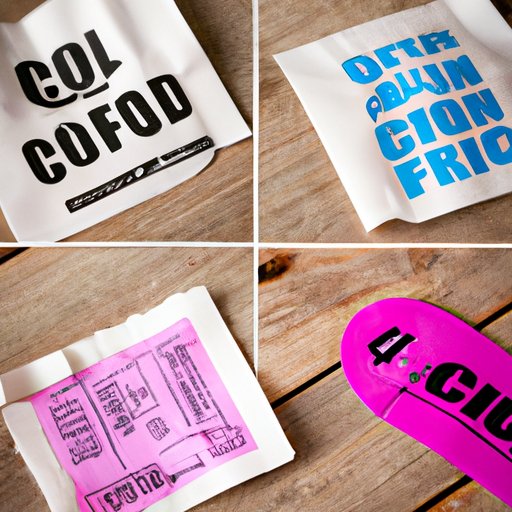I. Introduction
Have you ever accidentally left a sticker on a piece of clothing for too long, only to find an annoying residue on it afterwards? Sticker residue on clothes is a common problem, but luckily, there are plenty of ways to remove it. This article will provide tips and methods for getting sticker residue off clothes, including both DIY remedies and commercial stain removers. Read on for some easy and effective solutions!
II. Quick and easy DIY methods
If you’re looking for a quick and easy solution to getting sticker residue off clothes, you might want to try some DIY remedies. Vinegar, rubbing alcohol, and baking soda are all effective and easy to use.
Vinegar is a great option for removing sticky residue. Simply apply some vinegar to the area with a cloth and let it sit for a few minutes, then wash the clothing item as usual. Another easy option is rubbing alcohol. Apply some rubbing alcohol to a cloth and rub it over the residue until it comes off. Lastly, you can try using baking soda. Mix baking soda with water to create a paste, rub it onto the residue, and let it sit for a few minutes before washing it off as usual.
Remember to always test a small area first when using any of these methods, and be careful not to damage the fabric.
III. Commercial stain removers
If DIY remedies are not cutting it, you may want to try using a commercial stain remover. There are different types of stain removers available, including those specifically designed for removing adhesive residue.
When choosing a commercial stain remover, always read the label and follow the instructions carefully. Some popular commercial options for removing sticker residue include Goo Gone, OxiClean, and Zout. These have good reviews, but it’s always wise to do your own research and choose one that best fits your needs and budget.
For best results, apply the stain remover to the affected area, let it sit for the recommended amount of time, and then wash the clothing item as usual.
IV. Preventing sticker residue on clothes
Prevention is always better than cure. There are different techniques you can use to prevent sticker residue from sticking to your clothes in the first place, like using a barrier or removing stickers carefully.
One technique is to apply a barrier between the sticker and the clothing. You can use wax paper, masking tape, or clear packing tape to protect the fabric. Always test the tape on a small area first to ensure it won’t damage the fabric.
If you’re removing stickers from clothing, be sure to do it carefully and slowly to avoid tearing the fabric. You can also use a hair dryer to gently warm up the sticker and soften the adhesive.
V. Hot vs. cold water
When washing clothes with sticker residue, you may wonder whether to use hot or cold water. The answer depends on the type of fabric and adhesive, but generally, using hot water can help to dissolve the adhesive and make it easier to remove. However, hot water can also cause some fabrics to shrink or fade, so proceed with caution.
If you’re not sure, start by using warm water and see how effective it is. If the residue is stubborn, you can try increasing the temperature or using a pre-treatment before washing.
VI. Specialized techniques
Sometimes, stubborn sticker residue requires a more specialized approach. There are a few techniques you can try that involve using heat to soften the adhesive.
One method involves using a steam iron. Place a cloth over the affected area and use the steam setting on the iron to gently warm up the residue. Then scrape it off with a credit card or scraper.
Another technique involves using a hair dryer. Warm up the residue with the hair dryer and then scrape it off with a scraper or your fingernail. Be sure to keep the hair dryer moving and not to overheat the fabric.
VII. Conclusion
Sticker residue on clothes can be frustrating, but with these tips and methods, you can make it a thing of the past. Whether you prefer DIY remedies, commercial stain removers, or specialized techniques, there’s something for everyone. Remember to always test a small area first and be careful not to damage the fabric.
